Menu
Math Lesson 2.2.3 - Rounding through Intervals and Segments Explained
Please provide a rating, it takes seconds and helps us to keep this resource free for all to use
Welcome to our Math lesson on Rounding through Intervals and Segments Explained, this is the third lesson of our suite of math lessons covering the topic of Upper and Lower Bounds. Intervals and Segments, you can find links to the other lessons within this tutorial and access additional Math learning resources below this lesson.
Rounding through Intervals and Segments Explained
Intervals and segments can be used to explain rounding. More specifically, we use the concept of half-segment to indicate the possible values of a number which, when rounded, provides the same value. In this case, the number included in the lower bound is included in the set while, after the upper bound, there is always an "uncovered" part which is dictated by the precision of numbers involved.
For example, if a number is 30 when rounded to the nearest ten, we have taken the lower bound as 25 and the higher bound as 34. But when the rounded number is 40, this includes values from 35 to 44. It is clear that the part from 34 to 35 remains uncovered as long as we don't increase the precision of numbers to include non-whole values in the set.
To avoid these issues, we introduce the concept of a "half-segment" to represent the possible range of a rounding. We say "all numbers included in the half-segment [25, 34) are 30 when rounded to the nearest ten, this includes non-whole numbers". In this way, we no longer need to specify the set of numbers involved; all number sets have the same structure of representation when rounding to the nearest ten. The same can be said for other types of rounding (to the nearest hundred, thousand, unit, tenths, thousandths, etc.).
Example 8
Show, using symbols and number line, the set of numbers that are:
- 70 when rounded to the nearest ten.
- 400 when rounded to the nearest hundred.
- 9000 when rounded to the nearest thousand.
- 14 when rounded to the nearest unit.
- 5.6 when rounded to the nearest tenth.
Solution 8
- The numbers that are 70 when rounded to the nearest ten extend from 65 (including it) to 75 (without including it). Hence, when represented by symbols, this set is written as [65, 75). When shown in a number line, this set gives
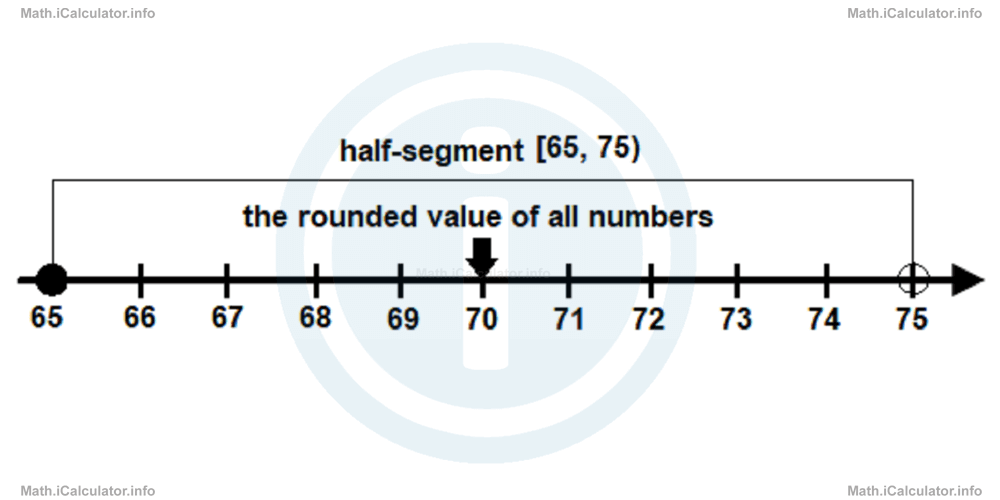
- The numbers that are 400 when rounded to the nearest hundred extend from 350 (including it) to 450 (without including it). Hence, when represented by symbols, this set is written as [350, 450). When shown in a number line, this set gives
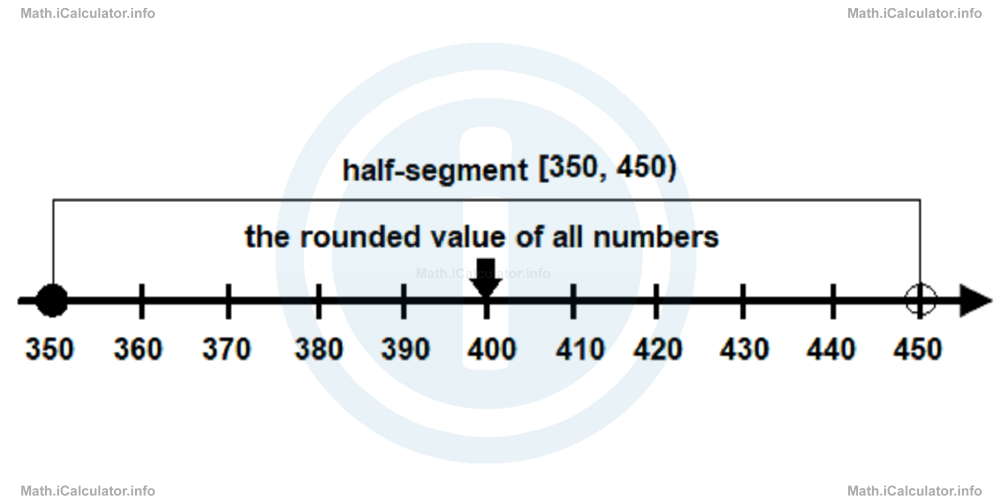
- The numbers that are 9000 when rounded to the nearest thousand extend from 8500 (including it) to 9500 (without including it). Hence, when represented by symbols, this set is written as [8500, 9500). When shown in a number line, this set gives
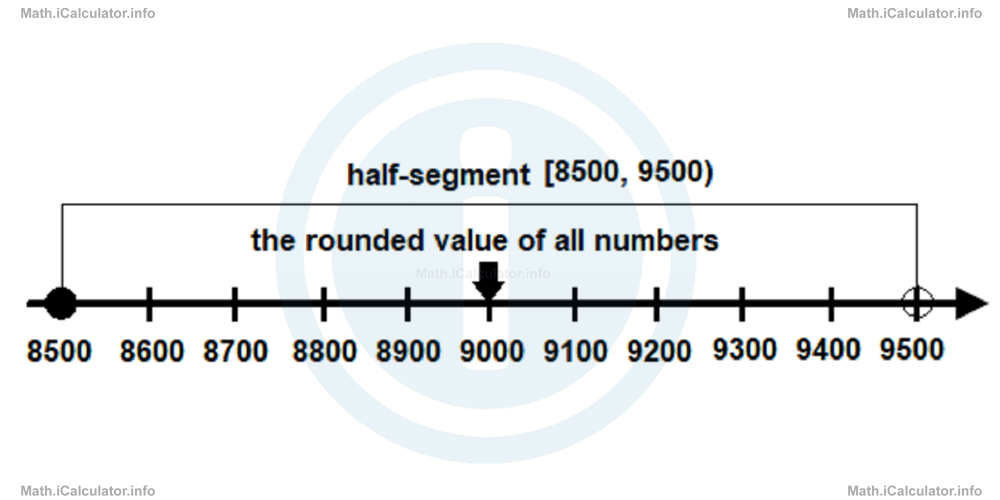
- The numbers that are 14 when rounded to the nearest unit extend from 13.5 (including it) to 14.5 (without including it). Hence, when represented by symbols, this set is written as [13.5, 14.5). When shown in a number line, this set gives
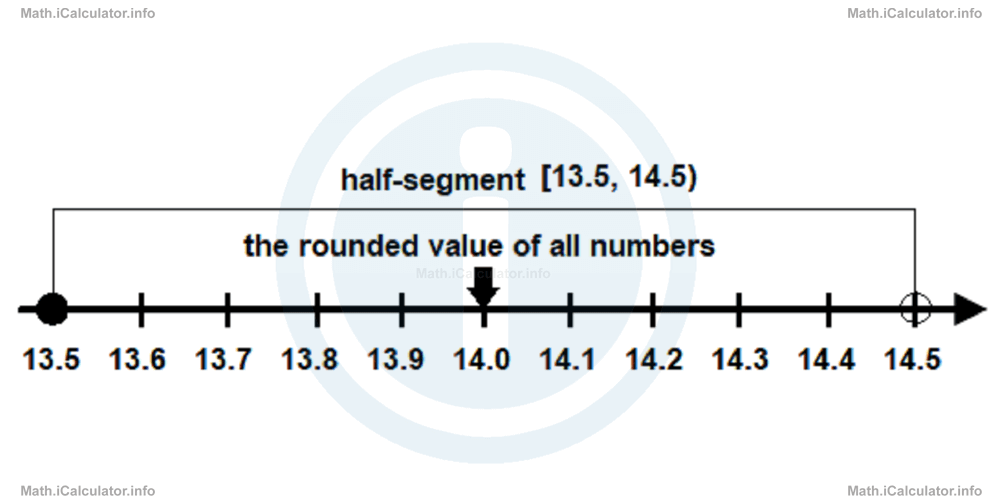
- The numbers that are 5.6 when rounded to the nearest tenth extend from 5.55 (including it) to 5.65 (without including it). Hence, when represented by symbols, this set is written as [5.55, 5.65). When shown in a number line, this set gives
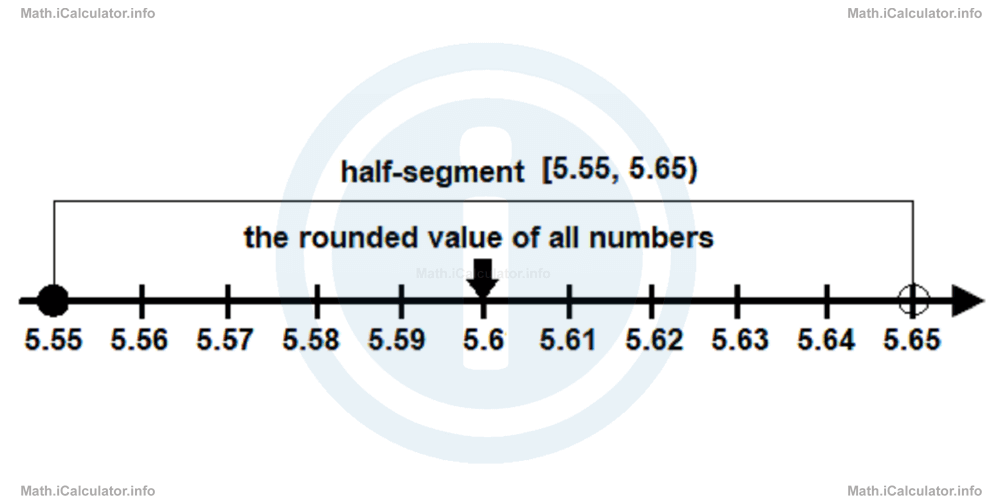 Remark! 5.60 and 5.6 represent the same number; the extra zero simply provides a higher precision in measurement.
Remark! 5.60 and 5.6 represent the same number; the extra zero simply provides a higher precision in measurement.
More Upper and Lower Bounds. Intervals and Segments Lessons and Learning Resources
Whats next?
Enjoy the "Rounding through Intervals and Segments Explained" math lesson? People who liked the "Upper and Lower Bounds. Intervals and Segments lesson found the following resources useful:
- Segments Explained Feedback. Helps other - Leave a rating for this segments explained (see below)
- Approximations Math tutorial: Upper and Lower Bounds. Intervals and Segments. Read the Upper and Lower Bounds. Intervals and Segments math tutorial and build your math knowledge of Approximations
- Approximations Video tutorial: Upper and Lower Bounds. Intervals and Segments. Watch or listen to the Upper and Lower Bounds. Intervals and Segments video tutorial, a useful way to help you revise when travelling to and from school/college
- Approximations Revision Notes: Upper and Lower Bounds. Intervals and Segments. Print the notes so you can revise the key points covered in the math tutorial for Upper and Lower Bounds. Intervals and Segments
- Approximations Practice Questions: Upper and Lower Bounds. Intervals and Segments. Test and improve your knowledge of Upper and Lower Bounds. Intervals and Segments with example questins and answers
- Check your calculations for Approximations questions with our excellent Approximations calculators which contain full equations and calculations clearly displayed line by line. See the Approximations Calculators by iCalculator™ below.
- Continuing learning approximations - read our next math tutorial: Rounding and Significant Figures
Help others Learning Math just like you
Please provide a rating, it takes seconds and helps us to keep this resource free for all to use
We hope you found this Math tutorial "Upper and Lower Bounds. Intervals and Segments" useful. If you did it would be great if you could spare the time to rate this math tutorial (simply click on the number of stars that match your assessment of this math learning aide) and/or share on social media, this helps us identify popular tutorials and calculators and expand our free learning resources to support our users around the world have free access to expand their knowledge of math and other disciplines.